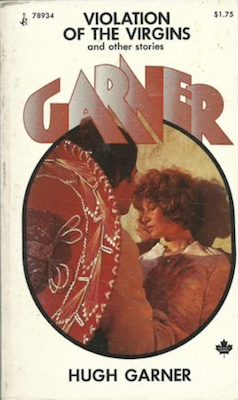 |
| Holy Deadlock A.P. Herbert Toronto: Harlequin, 1954 Cover: Syd Dyke |
Related posts:
A JOURNEY THROUGH CANADA'S FORGOTTEN, NEGLECTED AND SUPPRESSED WRITING
 |
| Lobby Girl Gerald Foster Toronto: News Stand Library |
 |
| Never See the Sun Hall Bennett 1950 |
 |
| Carnival of Love Anthony Scott 1950 |
 |
| Strange Desires Alan Malston 1950 |
 |
| Too Many Women Gerry Martin 1950 |
 |
| Hospital Nurse Lucy Agnes Hancock |
It is a novel so scarce that it cannot be found in Canada's largest public library, it's largest university library or even the National Library's copyright deposit.Odd thing about Garner: his books were graced with some of the most disturbing images. He was, of course, a Governor General's Award-winner, once considered one of our greatest short story writers, but you'd never know it to look at these.
 |
| Hugh Garner's Best Stories Richmond Hill, ON: Pocket Books, 1971 |
 |
| A Nice PLace to Visit Toronto: Ryerson, 1970 |
 |
| A Nice Place to Visit Richmond Hill, ON: Pocket Books, 1971 |
 |
| Violation of the Virgins Toronto: McGraw-Hill Ryerson, 1970 |
 |
| Violation of the Virgins Richmond Hill, ON: Pocket, 1975 |
Perhaps it's all the hype and determined salesmanship of McClelland and Stewart. Perhaps, more likely, it's that Rohmer neatly touches Canadian themes in a country starving for Canadian themes. Perhaps the very superficiality engages interest without emotion, so that there's no investment of the mind and spirit, and the reading is easy. Or perhaps we're just a not very discriminating public…Perhaps it's all four, but I think the second is key. My pre-teen self was starved for Canadian fiction, and the wire racks of Kane's Super Drug Mart in Kirkland, Quebec, provided what the Lakeshore School Board did not. Rohmer's talent lay in an uncanny ability to tap into his fellow citizens' fantasies and fears. Separation, about the threatened succession of Quebec, was published the month before the surprise victory of the Parti Québécois in the 1976 provincial election.
 |
| Pierre Trudeau and Joni Mitchell at her induction into the Canadian Music Hall of Fame, O'Keefe Centre, Toronto, 5 October 1981. |
 |
| Stephen Harper awards Justin Bieber the Diamond Jubilee Medal, Scotiabank Place, Ottawa, 23 November 2012. |
 |
| The Globe & Mail, 4 August 1990 |
 |
| The Gazette, 18 December 1958 |

